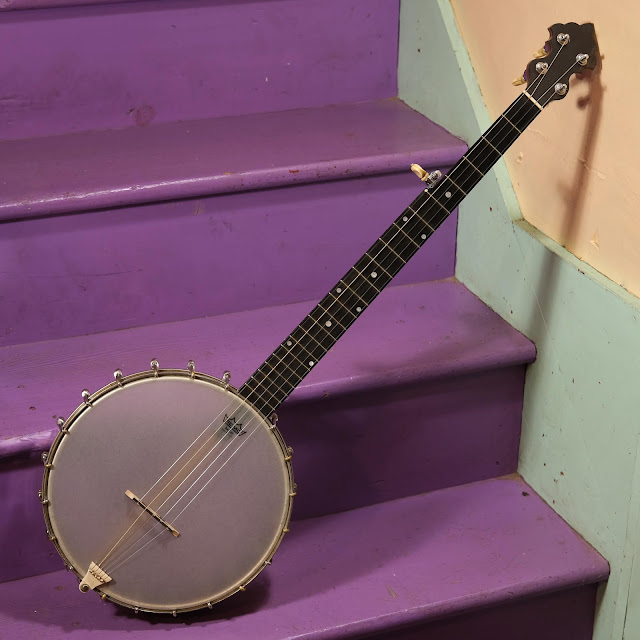1890s Weymann A-Scale 5-String Openback Banjo
I'd originally pegged this as a 1900s-era Weymann, but then on second-look I noticed no serial number and the ivory tailpiece. That puts this more in the late 1890s during Weymann's first batch of banjos. It's an interesting one, too, as most of the Weymann 5-strings from the time that I've worked-on have been 26"+ full-scale instruments while this one is more of the "usual Buckbee size" with its shorter, 24 9/16" scale. This is the scale I prefer on a 5-string as it puts my hand closer to the nut and thus my left-arm doesn't tire from farther stretches.
A local customer wanted this done-over after its original head split and I was happy to comply. Now that it's fixed, it has a full, rich, clean sound and a fast, easy feel that makes it a really, really enjoyable player. I'm a little smitten.
Work included: a fret level/dress, shim-up of the neck joint, replacement (compensated) saddle, cleaning, side dots install, new parts-bin geared pegs to replace a mismatched set of deathly friction pegs, a new Remo Renaissance head, and a setup with steel 9s. While I would've suggested Nylgut strings (as this was made for gut when new), the instrument had been strung with 10s for who-knows-how-long without a warped neck, so I figured steel 9s would be fine on it. It plays with 1/16" action at the 12th fret and, as mentioned, has a perfectly-straight neck.
Scale length: 24 9/16"Nut width: 1 3/16"String spacing at nut: 1"String spacing at bridge: 1 3/4"Head diameter: 10 1/2"
Side depth: 2 1/2"
Rim wood: maple or similar with nickel-plated cladding
Neck wood: mahoganyFretboard: ebonyNeck shape: slim-to-medium V-shape, flat boardBridge: maple/ebony 1/2"Nut: original boneTonering: curled-over hoop-in-metal-cladding
Side depth: 2 1/2"
Rim wood: maple or similar with nickel-plated cladding
Neck wood: mahoganyFretboard: ebonyNeck shape: slim-to-medium V-shape, flat boardBridge: maple/ebony 1/2"Nut: original boneTonering: curled-over hoop-in-metal-cladding
The newer, 4:1 geared pegs make a world a difference for tuning ease and stability. I used antique buttons to make them look a little more period-appropriate.
Because the shim-style neck braces never hold-up tension-wise with traveling or daily use, I added a neck bolt to keep the neck rigid to the pot as well.















Comments